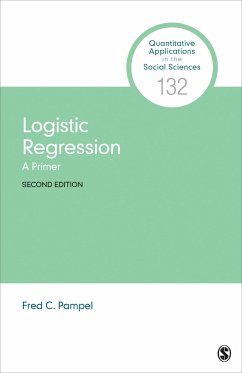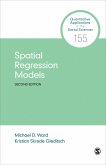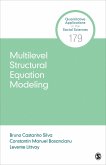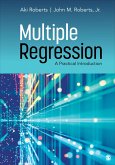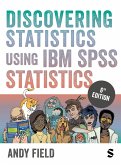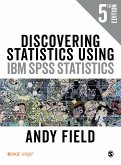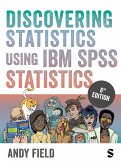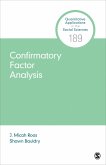- Broschiertes Buch
- Merkliste
- Auf die Merkliste
- Bewerten Bewerten
- Teilen
- Produkt teilen
- Produkterinnerung
- Produkterinnerung
This volume helps readers understand the intuitive logic behind logistic regression through nontechnical language and simple examples.
Andere Kunden interessierten sich auch für
![Spatial Regression Models Spatial Regression Models]() Michael D. WardSpatial Regression Models49,99 €
Michael D. WardSpatial Regression Models49,99 €![Multilevel Structural Equation Modeling Multilevel Structural Equation Modeling]() Bruno Castanho SilvaMultilevel Structural Equation Modeling49,99 €
Bruno Castanho SilvaMultilevel Structural Equation Modeling49,99 €![Multiple Regression Multiple Regression]() Aki Roberts (USA University of Wisconsin-Milwaukee)Multiple Regression121,99 €
Aki Roberts (USA University of Wisconsin-Milwaukee)Multiple Regression121,99 €![Discovering Statistics Using IBM SPSS Statistics Discovering Statistics Using IBM SPSS Statistics]() Andy FieldDiscovering Statistics Using IBM SPSS Statistics56,99 €
Andy FieldDiscovering Statistics Using IBM SPSS Statistics56,99 €![Discovering Statistics Using IBM SPSS Statistics Discovering Statistics Using IBM SPSS Statistics]() Andy FieldDiscovering Statistics Using IBM SPSS Statistics217,99 €
Andy FieldDiscovering Statistics Using IBM SPSS Statistics217,99 €![Discovering Statistics Using IBM SPSS Statistics Discovering Statistics Using IBM SPSS Statistics]() Andy FieldDiscovering Statistics Using IBM SPSS Statistics181,99 €
Andy FieldDiscovering Statistics Using IBM SPSS Statistics181,99 €![Confirmatory Factor Analysis Confirmatory Factor Analysis]() J. Micah Roos (Virginia Polytechnic Institute and State UniversityConfirmatory Factor Analysis50,99 €
J. Micah Roos (Virginia Polytechnic Institute and State UniversityConfirmatory Factor Analysis50,99 €-
-
-
This volume helps readers understand the intuitive logic behind logistic regression through nontechnical language and simple examples.
Hinweis: Dieser Artikel kann nur an eine deutsche Lieferadresse ausgeliefert werden.
Hinweis: Dieser Artikel kann nur an eine deutsche Lieferadresse ausgeliefert werden.
Produktdetails
- Produktdetails
- Quantitative Applications in the Social Sciences
- Verlag: SAGE Publications Inc
- 2 Revised edition
- Seitenzahl: 152
- Erscheinungstermin: 15. Oktober 2020
- Englisch
- Abmessung: 217mm x 145mm x 12mm
- Gewicht: 190g
- ISBN-13: 9781071816202
- ISBN-10: 1071816209
- Artikelnr.: 59547057
- Herstellerkennzeichnung
- Libri GmbH
- Europaallee 1
- 36244 Bad Hersfeld
- gpsr@libri.de
- Quantitative Applications in the Social Sciences
- Verlag: SAGE Publications Inc
- 2 Revised edition
- Seitenzahl: 152
- Erscheinungstermin: 15. Oktober 2020
- Englisch
- Abmessung: 217mm x 145mm x 12mm
- Gewicht: 190g
- ISBN-13: 9781071816202
- ISBN-10: 1071816209
- Artikelnr.: 59547057
- Herstellerkennzeichnung
- Libri GmbH
- Europaallee 1
- 36244 Bad Hersfeld
- gpsr@libri.de
FRED C. PAMPEL is Research Professor of Sociology and a Research Associate in the Population Program at the University of Colorado Boulder. He received a Ph.D. in sociology from the University of Illinois, Champaign-Urbana, in 1977, and has previously taught at the University of Iowa, University of North Carolina, and Florida State University. His research focuses on socioeconomic disparities in health behaviors, smoking in particular, and on the experimental and quasi-experimental methods for evaluation of social programs for youth. He is the author of several books on population aging, cohort change, and public policy, and his work has appeared in the American Sociological Review, the American Journal of Sociology, Demography, Social Forces, and the European Sociological Review.
Series Editor's Introduction
Preface
Acknowledgments
About the Author
Chapter 1: The Logic of Logistic Regression
Regression With a Binary Dependent Variable
Transforming Probabilities Into Logits
Linearizing the Nonlinear
Summary
Chapter 2: Interpreting Logistic Regression Coefficients
Logged Odds
Odds
Probabilities
Standardized Coefficients
Group and Model Comparisons of Logistic Regression Coefficients
Summary
Chapter 3: Estimation and Model Fit
Maximum Likelihood Estimation
Tests of Significance Using Log Likelihood Values
Model Goodness of Fit
Summary
Chapter 4: Probit Analysis
Another Way to Linearize the Nonlinear
The Probit Transformation
Interpretation
Maximum Likelihood Estimation
Summary
Chapter 5: Ordinal and Multinomial Logistic Regression
Ordinal Logistic Regression
Multinomial Logistic Regression
Summary
Notes
Appendix: Logarithms
The Logic of Logarithms
Properties of Logarithms
Natural Logarithms
Summary
References
Index
Preface
Acknowledgments
About the Author
Chapter 1: The Logic of Logistic Regression
Regression With a Binary Dependent Variable
Transforming Probabilities Into Logits
Linearizing the Nonlinear
Summary
Chapter 2: Interpreting Logistic Regression Coefficients
Logged Odds
Odds
Probabilities
Standardized Coefficients
Group and Model Comparisons of Logistic Regression Coefficients
Summary
Chapter 3: Estimation and Model Fit
Maximum Likelihood Estimation
Tests of Significance Using Log Likelihood Values
Model Goodness of Fit
Summary
Chapter 4: Probit Analysis
Another Way to Linearize the Nonlinear
The Probit Transformation
Interpretation
Maximum Likelihood Estimation
Summary
Chapter 5: Ordinal and Multinomial Logistic Regression
Ordinal Logistic Regression
Multinomial Logistic Regression
Summary
Notes
Appendix: Logarithms
The Logic of Logarithms
Properties of Logarithms
Natural Logarithms
Summary
References
Index
Series Editor's Introduction
Preface
Acknowledgments
About the Author
Chapter 1: The Logic of Logistic Regression
Regression With a Binary Dependent Variable
Transforming Probabilities Into Logits
Linearizing the Nonlinear
Summary
Chapter 2: Interpreting Logistic Regression Coefficients
Logged Odds
Odds
Probabilities
Standardized Coefficients
Group and Model Comparisons of Logistic Regression Coefficients
Summary
Chapter 3: Estimation and Model Fit
Maximum Likelihood Estimation
Tests of Significance Using Log Likelihood Values
Model Goodness of Fit
Summary
Chapter 4: Probit Analysis
Another Way to Linearize the Nonlinear
The Probit Transformation
Interpretation
Maximum Likelihood Estimation
Summary
Chapter 5: Ordinal and Multinomial Logistic Regression
Ordinal Logistic Regression
Multinomial Logistic Regression
Summary
Notes
Appendix: Logarithms
The Logic of Logarithms
Properties of Logarithms
Natural Logarithms
Summary
References
Index
Preface
Acknowledgments
About the Author
Chapter 1: The Logic of Logistic Regression
Regression With a Binary Dependent Variable
Transforming Probabilities Into Logits
Linearizing the Nonlinear
Summary
Chapter 2: Interpreting Logistic Regression Coefficients
Logged Odds
Odds
Probabilities
Standardized Coefficients
Group and Model Comparisons of Logistic Regression Coefficients
Summary
Chapter 3: Estimation and Model Fit
Maximum Likelihood Estimation
Tests of Significance Using Log Likelihood Values
Model Goodness of Fit
Summary
Chapter 4: Probit Analysis
Another Way to Linearize the Nonlinear
The Probit Transformation
Interpretation
Maximum Likelihood Estimation
Summary
Chapter 5: Ordinal and Multinomial Logistic Regression
Ordinal Logistic Regression
Multinomial Logistic Regression
Summary
Notes
Appendix: Logarithms
The Logic of Logarithms
Properties of Logarithms
Natural Logarithms
Summary
References
Index

